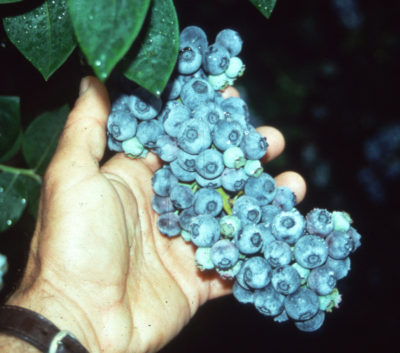BLUEBERRIES AND ASPARAGUS (SEPARATELY)
/25 Comments/in Gardening/by Lee ReichAll Good
I’ve never met a blueberry I didn’t like. Then again, I have yet to taste a rabbiteye blueberry (Vaccinium asheii), native to southeastern U.S. and highly acclaimed there. I also have yet to taste Cascades blueberry (V. deliciosum), native to the Pacific northwest. With “deliciosum” as its species name, how could it not taste great? And those are just two of the many species of blueberry that I’ve never tasted that are found throughout the world.
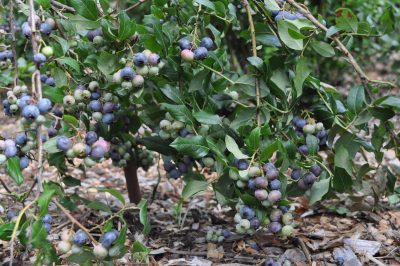 The blueberries with which I am most familiar are those that I grow, which are highbush blueberry and lowbush blueberry. I grow blueberries because they are beautiful plants, because they are relatively pest free, because they are delicious, and because they fruit reliably for me year after year.
The blueberries with which I am most familiar are those that I grow, which are highbush blueberry and lowbush blueberry. I grow blueberries because they are beautiful plants, because they are relatively pest free, because they are delicious, and because they fruit reliably for me year after year.
I have to admit that highbush blueberries, at least to me, all taste pretty much the same. They have nowhere the broad flavor spectrum of apples. Tasting the same is fine with me; as I wrote, they are delicious. Depending on the variety, the berries do vary in ripening season, size, and other less obvious characteristics. One very important influence on flavor is how they are picked. Blueberries turn blue a few days before they are at their peak flavor, which is okay if you’re marketing them and just want them blue. But the best tasting tasting, dead-ripe ones are those that drop into your hand as you tickle a bunch of berries, which makes a good case for growing them near your back door.
Lowbush blueberries also taste pretty much the same from plant to plant, but their flavor is decidedly different from that of highbush blueberries, a more metallic sweetness. Few varieties of lowbush blueberry exist, so most plants are just random seedlings anyway. Not to disparage that, though; they’re also all delicious — if picked at the right moment.
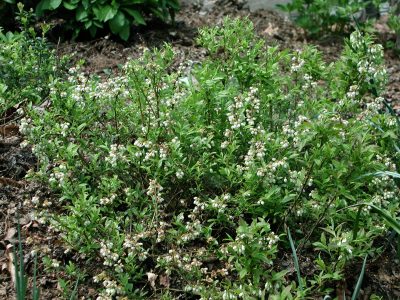
A Different Blueberry
My idea that all highbush blueberries taste pretty much the same was recently challenged. New highbush varieties have been bred or selected since this native fruit went, over the past 100 years, from being harvested from mostly from the wild to being mostly cultivated. Over the years I’ve been very pleased with the nine varieties I had been growing, spreading out the harvest season from late June until early September.
Then the new variety, Nocturne, bred by Dr. Mark Ehlenfeldt of the USDA, caught my eye. Besides being billed as having unique flavor, Nocturne was also said to be notable for its jet-black fruits which, before they turn jet black, are vivid red-orange in color. What attracted me wasn’t the fruit’s unique colors, but its allegedly unique flavor atypical, so the description read, of either rabbiteye [which is in Nocturne’s lineage] or highbush.”

So I called Mark to learn more about the variety. One of the original breeding goals back 25 years ago, when Nocturne’s carefully selected parents were mated, was to get a rabbiteye variety that, blooming later than most, would be less susceptible to spring frosts. Chemically, two significant differences between rabbiteye and highbush blueberries are their organic acids. Rabbiteyes have mostly malic and succinic acids, yielding a flatter taste profile than highbush fruits, whose citric acid makes for a brighter, sharper flavor. Other species were also thrown into the mix, including Constable’s blueberry (V. constablaei), a native of higher elevations in southeastern U.S., and contributing late blooming and excellent flavor.
Long story short: Nocturne is significant for being a variety with significant rabbiteye parentage that is winter hardy to well below zero degrees Fahrenheit and late blooming. It has excellent flavor, juicy sweet, and sprightly, and quite different from my other highbush varieties. Nocturne tastes even juicier than it is. Which do I like better? Neither, I like them all. Nocturne, now in its third year here on the farmden, now has a permanent place in my Blueberry Temple.
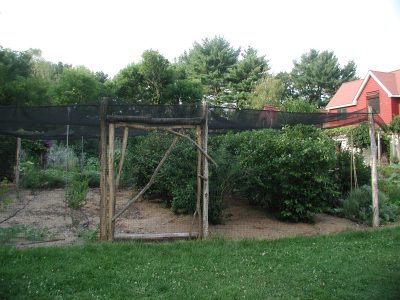
Blueberry Temple
Learn the Ins and Outs of Growing Blueberries
If you have the space, grow blueberries. To that end, I will be holding a zoom workshop/webinar on growing blueberries on August 12, 2020 from 7-8:30 pm EST. I’ll cover everything from planting right through harvest and preservation. If you’re new to growing blueberries, you’ll learn how to grow this fruit successfully. If you already grow blueberries, you’ll be able to grow them better. If you’re an expert on growing blueberries, you don’t need this workshop/webinar. Registration ($35) is a must as space is limited; registration link is
https://us02web.zoom.us/webinar/register/WN_NSTrunuTRkOcRfS-frQuYg. For more information, go to https://leereich.com/workshops.
Asparagus Redux
On a totally different topic, I’d like to followup on my end-of-harvest-season treatment of asparagus. Weeds have always been somewhat problematic in my asparagus bed. Harvest ceases at the end of June so plants can grow freely and feed energy to the roots which will fuel the following year’s spears in spring. Weeds quickly move into this hard-to-weed area.
As I wrote on this blog a few weeks ago, this past June, at the end of asparagus harvest season, I mowed everything, weeds as well as emerging asparagus spears, to the ground with my scythe. I then blanketed the ground with a thick mulch. I first laid down an inch depth of compost, which will feed the soil as well as smother roots, and then topped that with another inch or two of wood chips.
There was the danger of smothering the emergence of new asparagus shoots, but plenty have pushed up through the mulch.
As far as weeds, there are very few. Most of them appear at the grassy edge of the bed.
Success!
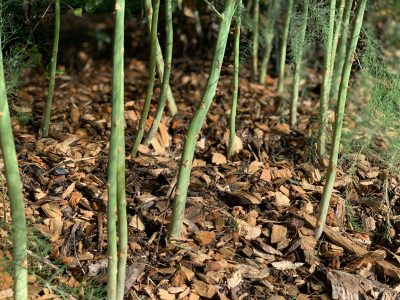
UPDATED INFORMATION ABOUT BLUEBERRY WEBINAR
/2 Comments/in Gardening/by Lee ReichFor updated information about this month’s BLUEBERRY GROWING webinar, go to https://leereich.com/workshops.
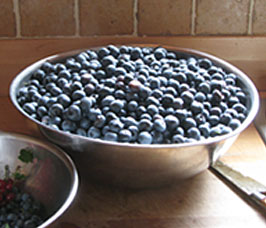
OF COMPOST, MICROWAVES, AND BLUEBERRIES
/15 Comments/in Fruit, Soil/by Lee ReichManure Unnecessary
Manure or not, it’s compost time. I like to make enough compost through summer so that it can get cooking before autumn’s cold weather sets in. Come spring, I give the pile one turn and by the midsummer the black gold is ready to slather onto vegetable beds or beneath choice trees and shrubs.
I haven’t gotten around to getting some manure for awhile so I just went ahead this morning and started building a new pile without manure. It’s true: You do not need manure to make compost. Any pile of organic materials will decompose into compost given enough time.

My piles are a little more deliberate than mere heaps of organic materials. For one thing, everything goes into square bins each about 4′ on a side and built up, along with the materials within, Lincoln-log style from notched 1 x 6 manufactured wood decking. Another nice feature of this system is that the compost is easy to pitchfork out of the pile as sidewalls are removed with the lowering compost.
My main compost ingredient is hay that I scythe from an adjoining field. As this material is layered and watered into the bin it also gets sprinkled regularly with some soil and limestone. Soil adds some bulk to the finished material. The limestone adds alkalinity to offset the naturally increasing acidity of many soils here in the Northeast. Into the pile also goes any and all garden and kitchen refuse whenever available.
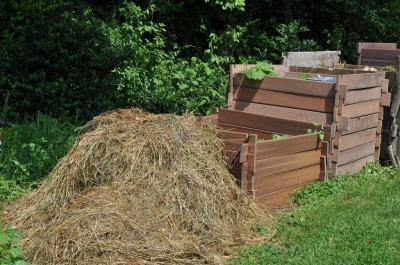
What manure adds to a compost pile is bedding, usually straw or wood shavings, and what comes out of the rear end of the animal. The latter is useful for providing nitrogen to balance out the high carbon content of older plant material in the compost, such as my hay.
But manure isn’t the only possible source of nitrogen. Young, green, lush plants are also high in nitrogen, as are kitchen trimmings, hair, and feathers. Soybean meal, or some other seed meal, is another convenient source.
Compost piles fed mostly kitchen trimmings or young plants benefit from high carbon materials. Otherwise, these piles become too aromatic, not positively.
As I wrote above, “Any pile of organic materials will decompose into compost given enough time.” Nitrogen speeds up decomposition of high carbon compost piles, enough to shoot temperatures in the innards of the pile to 150° or higher. All that heat isn’t absolutely necessary but does kill off most pests, including weed seeds, quicker than slow cooking compost piles.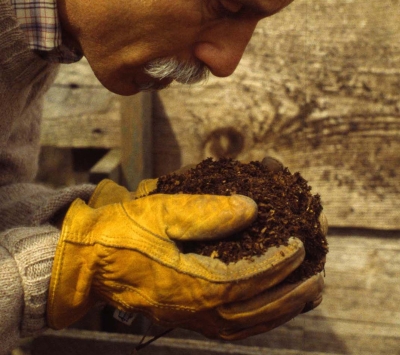
Plus, it’s fun nurturing my compost pets, the microorganisms that enjoy life within a compost pile.
Novel Use for Microwave
I bought my first (and only) microwave oven a few years ago ($25 on craigslist) and have cooked up many batches of soil in it. You thought I was going to use it to cook food? Nah.
Usually, I don’t cook my potting soils, which I make by mixing equal parts sifted compost, garden soil, peat moss, and perlite, with a little soybean meal for some extra nitrogen. I avoid disease problems, such as damping off of seedlings, with careful watering and good light and air circulation rather than by sterilizing my potting soils.
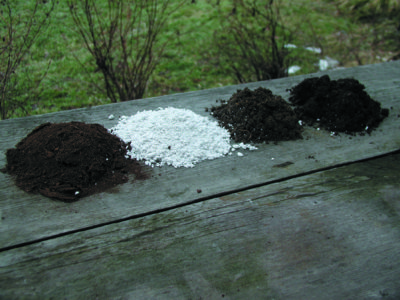
Peat, perlite, soil, and compost
Recently, however, too many weeds have been sprouting in my potting soil. Because my compost generally gets hot enough to snuff out weed seeds and because peat and perlite are naturally weed-free, these ingredients aren’t causing the problem. Garden soil in the mix is the major source of weeds.
So I cook up batches of garden soil, using the hi setting of the microwave oven for 20 minutes. My goal is to get the temperature up to about 180 degrees F., which does NOT sterilize the soil, but does pasteurize it. Overheating soil leads to release of ammonia and manganese, either of which can be toxic to plants. Sterilizing it also would leave a clean slate on which any microorganism, good or bad, could have a field day. Pasteurizing the soil, rather than sterilizing it, leaves some good guys around to fend off nefarious invaders.
After the soil cools, I add it to the other ingredients, mix everything up thoroughly, and shake and rub it through ½ inch hardware cloth mounted in a frame of two-by-fours. This mix provides a good home for the roots of all my plants, everything from my lettuce seedlings to large potted fig trees.
Blueberry Webinar
Blueberries, as usual, are bearing heavily this year, with over 60 quarts already in the freezer and almost half that amount in our bellies. After years of growing this native fruit, it has never failed me, despite some seasons of too little rain, some of too much rain, late frost, or other traumas suffered by fruit crops generally.
All of which leads up to my invitation to you to come (virtually) to my upcoming Blueberry Workshop webinar. This webinar will cover everything from choosing plants to planting to the two important keys to success with blueberries, pests, harvest, and preservation. And, of course, there will be opportunity for questions. For more and updated information, keep and eye on www.leereich.com/workshops, the “workshops” page of my website.
